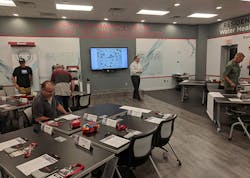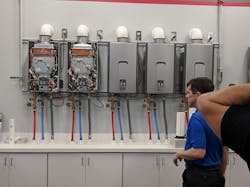Latest from Training
Sponsored
PEACHTREE CITY, GA — The workforce crunch that all the skilled trades are experiencing has put many contractors in an impossible situation. On the one hand, hiring new people and training them up seems the best solution; you get technicians you know are trained correctly, who are on-board with your company’s mission, and who (hopefully) see you and your company as the gateway to a rewarding career and a better life.
On the other hand, who has the time and money to train these new people? Training rooms are space that could be given to stock, back-office workers, vehicles or fabrication. Dedicated trainers cost money. If you make one of your senior technicians into a trainer it takes time out of their schedule when they could be on the job. Textbooks cost money. Testing costs money. Certifications cost money.
On the other other hand, you can’t afford to be one of those shops that takes on people and then only teaches them just enough to do one or two specific jobs — say, make connections with a press tool, or snake a drain, or install a bathtub. You end up with a shop full of surly, disgruntled half-techs; guys who have to spend all day riding around with or working alongside of your more experienced people and see themselves denied the opportunity for a career and the better money that goes with it. (And besides, it makes scheduling a nightmare. Dave? Nope, can’t send Dave, Dave only knows bathtubs.)
For more and more contractors, manufacturers are helping carry the training load.
Manufacturers investing in training
A prime example can be found in Peachtree City, GA, where Rinnai America has its North American Headquarters and Training Center. The company has made a huge commitment to training. This year alone it is going to train about 50,000 technicians in the installation and service of its boilers, tankless water heaters, hybrid water heating products and more.
Led by the company’s Director of Training and Development, Troy Danahey, Rinnai currently boasts 11 field trainers, 150 sales and installation trainers, and in 2016 offered more than 26,000 total course experiences (and are striving to expand that to 50,000).
Those experiences range the gamut from classes to videos, job aids, webinars, E and M learning (that is, electronic learning on your computer and mobile learning on your smartphone or other mobile device) and prep and confirm games.
The goal is to create what Rinnai calls, “confident, capable, brand advocates.”
And, of course, you can always get hands-on training at places like Rinnai’s Training Center. The Center recently hosted a portion of “The Rinnai Experience,” a combination of training, networking and events the company invites dealers, plumbing/heating contractors, members of the trade press, and homebuilders to attend.
During the Experience attendees were able to get hands-on with the new Sensei tankless water heater and actually disassemble one. During a different session, attendees learned how the company’s MSB board can connect up to five tankless units so they all perform as a single system. Another session gave an overview of the Control-R wireless solution. (The Experience also included tours of Rinnai’s R&D lab, their distribution center and their new manufacturing facility.)
The company offers so many different types of training – and so many different training tools – because they’ve done their research. Some quick numbers:
· Only 1 percent of a typical workweek is all the time most employees have to focus on training and development
· Most workers are distracted; they will not typically watch videos longer than 4 minutes
· Most workers are impatient; online designers now have just between 5 and 10 seconds to grab a viewer’s attention
· More workers are untethered; nearly 30 percent of full-time employees do most of their work from somewhere other than their employer’s location
· 80 percent of workforce learning happens via on-the-job interactions with peers, teammates and managers
To help address all these factors and more, Rinnai is developing training that is more contextual, more collaborative, and more creative. The big word in training these days is “gamification,” where the training experience becomes less like sitting in a classroom and more like playing a game with co-workers.
For managers, they can deliver metrics to help follow the progress your employees are making in their training, and then compare that progress to either a national average, or the average in some other location (say, your county or a neighboring county).
Tech support
No matter how well trained a technician is on a piece of equipment, they can still get stumped by a difficult problem from time to time. That’s why they created the technical support call line. Rinnai offers real-time assistance for field techs and installers 24/7/365. Last year they managed to help 116,000 techs.
The company also offers an entire library of online data to help troubleshoot problems in the form of pdf documents and YouTube videos.
But why not head-off problems before they even start? So many problems have their origins in either a poor design, or a poorly executed design. Rinnai’s application engineers are available to help with sizing calculations, system set-ups, piping solutions, controls and much more.
Maximizing your workforce
But manufacturers have also been trying to address the workforce crunch from the other end: helping contractors do more jobs, faster, with fewer skilled technicians.
A lot of that effort has been through product design. The Sensei tankless heater, for example, for all its performance features, offers most Common Venting options to help make the installer’s job easier. In addition, installers can now vent with 2” PVC (NEW) up to 65’, or vent with 2”/4” (NEW) or 3”/5” concentric pipe. When it comes time to service the unit, all major components are easy to access, and any one of them can be changed out in under ten minutes.
Units can be pre-plumbed for typical applications, with all necessary brazing done at Rinnai’s manufacturing facility, meaning less work to do in the field. For atypical applications, the company can do made-to-orders for specialty jobs. The turnaround is about 15 days.
Why is Rinnai – and why are so many other manufacturers – going to such extraordinary lengths? Two simple reasons. First, manufacturers make claims about what their products can do: how efficient they are, how quiet they are, how quickly they can satisfy a customer’s demand. Products that are installed incorrectly (and a lot of the high-tech water heating appliances Rinnai sells have very specific demands and tolerances) don’t perform as promised. And then who does the consumer end up blaming? More likely than not the manufacturer.
Second, contractors tend to be the people closest to the end customers. If the contractor has done his job right, it is his brand recommendations the customer will be listening to. The goal is to create what Rinnai calls, “confident, capable, brand advocates.” Customers get the products they need, performing just as they were designed, and both the contractors and the manufacturers get happy customers. Everybody wins.
Steve Spaulding | Editor-inChief - CONTRACTOR
Steve Spaulding is Editor-in-Chief for CONTRACTOR Magazine. He has been with the magazine since 1996, and has contributed to Radiant Living, NATE Magazine, and other Endeavor Media properties.




